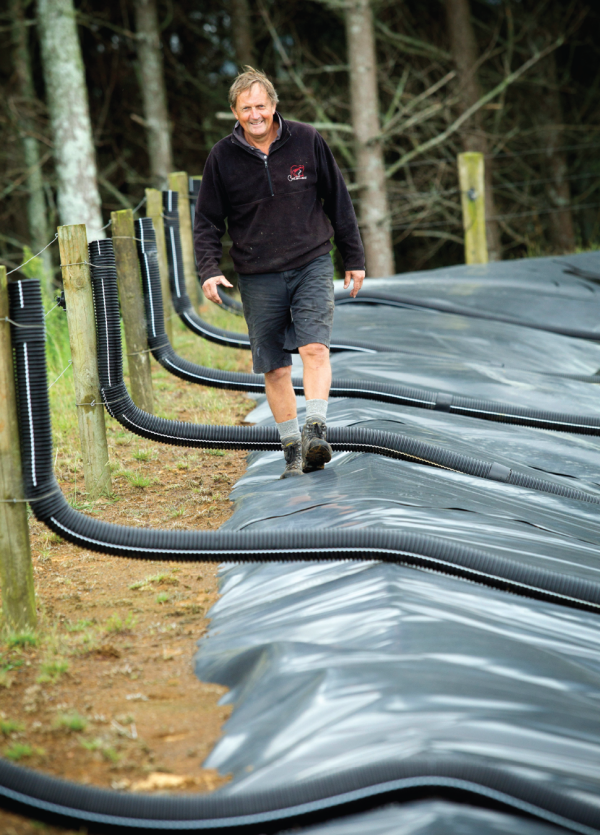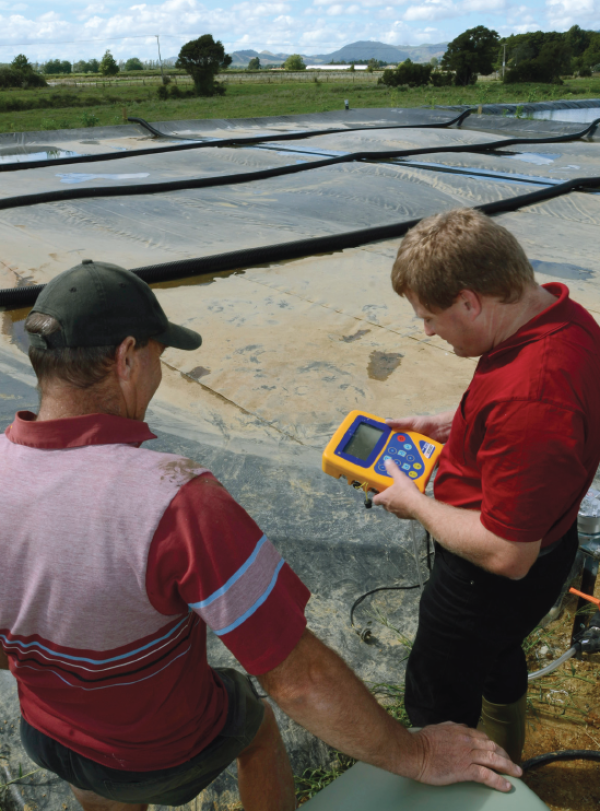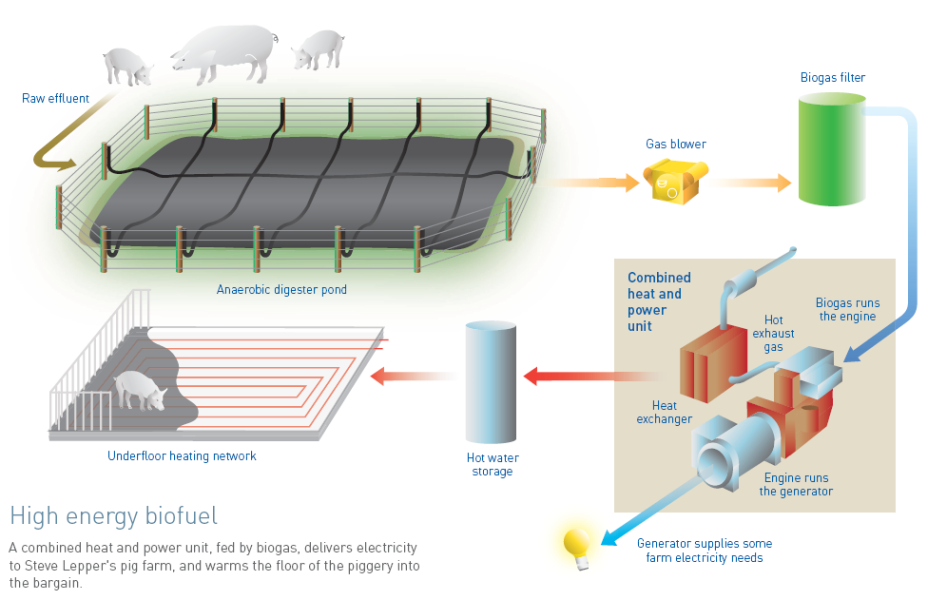Right now, millions of cubic metres of biogas either gets flared off, or wafts downwind to annoy the neighbours. But that gas could be generating electricity, powering vehicles and balancing our trade deficit at the same time, finds Dave Hansford.
Something had to happen. From downwind, complaints were starting to come, and Steve Lepper knew that fines would be coming too. He got to thinking....
To be fair, pig poo can smell pretty bad, and Lepper's farrowto- finish farm, at – where else? – Lepperton, in Taranaki, makes an awful lot of it. Four hundred sows produce 9500 piglets a year, and, in that time, they get through more than 2000 tonnes of feed. That produces several hundred tonnes of manure solids – and a waste problem.
Since the eighties, when the Leppers built the piggery, the consequences of all that gluttony had been treated in two large effluent ponds close – too close, it turned out – to Lepperton. Meanwhile, the piggery was running up monthly power bills of between $6000 and $7000.
Both problems had the same solution – a purpose-built covered anaerobic digester pond. The pig effluent is still treated in the 7200 cubic-metre (m³) pond. Nowadays, a heavy-duty plastic cover traps the offending odour – and something much more powerful: a renewable, high energy biofuel.
Each day, the cover traps around 300m³ of biogas, containing about 200m³ of methane, which is drawn off through a network of collecting pipes. The gas is compressed, then pumped through a scrubber to neutralise hydrogen sulphide, the cause of so many bad smells and complaints. Once scrubbed, the gas powers a petrol engine, which in turn spins a 40 kilowatt electricity generator.
In its first month, the system produced 133m³ of gas a day, and daily electricity use in the piggery fell by 28 per cent. Two hundred cubic metres of methane now supply roughly half the piggery's daily electricity needs, but the benefits don't stop there: heat exchangers take the engine's heat – which is otherwise wasted energy – and use it to heat water to 80ºC, sufficient to warm part of the piggery via under-floor pipes. That's reduced reliance on costly, inefficient radiant heat lamps.
As the biogas system continues to grow and improve, more hot water heating panels will further reduce the need for heat lamps. Lepper expects to recoup his $120,000 investment ($30,000 came from an Energy Efficiency and Conservation Authority (EECA) grant) within three years, and he no longer has to worry about energy blackouts.
In 2010, the Lepper biogas system won the Small-Medium Business category in the EECA awards.
Taranaki Regional Council's happy too: they consented the project, subject to special conditions on Lepper's water discharge, water abstraction and air discharge permits. They've watched with interest as the country's first new biogas digester in 20 years signals what a Council report says could be a more common solution to "new regulatory conditions," citing cleaner waste water discharge and fewer greenhouse gas emissions as just two reasons why they should see more widespread use. In 2010, the Council presented the Leppers with an environment award.
The digester pond was designed by NIWA Research Engineer Stephan Heubeck, applying the results of five years of NIWA research into anaerobic digestion. Heubeck's designed covered anaerobic piggery ponds before, but the objective had only been to control odour: the biogas was simply flared off. Lepper's is New Zealand's first full co-generation design based on covered anaerobic pond technology.
"Piggeries are one of the best sites to do this," says Heubeck, "because they have a high waste output and a high demand for electricity and heat."
Energy independence, reduction of greenhouse gas emissions (the process slashes fugitive methane emissions), and better effluent management are all seen as secondary benefits by pig farmers, says Heubeck. "To some degree it's the tail wagging the dog (or the pig?). The big motivation for the New Zealand pork industry is the reduction of waste odour, but anaerobic digestion provides an excellent opportunity to utilise that biogas, with all the associated benefits."
He points out that the first oil shock in the early eighties spurred kiwi ingenuity into building dozens of digesters around the country, mostly producing gas to fuel vehicles. But when oil prices dropped again a decade later, they shut down one by one, leaving only Fonterra's industrial plant at Tirau.
Now, he says, "there's renewed interest in these systems, and I think we'll see more built in the next few years." Farmers at large, says Heubeck, will learn and benefit from Lepper's "pioneering spirit."
Biogas digesters have broad potential, but he says current economics mean they will necessarily be confined for the time being to "situations where you can link the supply of manure feedstock to a local demand for electricity and/or heat. Often, you don't have both in the same place."
In Lepper's case, the feedstock supply couldn't be much closer to the end use.
His next step is to adapt the concept for the dairy sector, where, he says, it could find application on up to 10,000 New Zealand dairy farms. Over the next few years, he points out, more stringent dairy effluent regulations will see more and more farmers constructing storage ponds.
It would make perfect sense, says Heubeck, to build biogas recovery systems into those new pond systems up front, or at least leave provision for retrofits.
"Covered anaerobic pond technology is a smart pretreatment option for deferred dairy effluent irrigation systems. At present, methane recovery from such systems remains one of the very few practical options for reducing greenhouse gas (GHG) emissions in the dairy sector, and, with energy prices increasing all the time, utilising a locally available, waste-derived energy resource is becoming more financially attractive."
Those benefits haven't gone unnoticed across the Tasman. Encouraged by New Zealand success, industry association Australian Pork Ltd (APL), has collaborated with NIWA and various pork producers to design and build covered anaerobic biogas systems in most of Australia's key agricultural regions. Four systems are currently at various stages of construction, with more in the pipeline.
Australia has also embraced their potential to reduce GHG emissions, says Heubeck. With help from NIWA and other supporters, APL has designed a method to quantify GHG emission reductions from utilising pig manure methane.
Approved under the Australian Carbon Farming Initiative, the methodology opens the door to incentives for Australian pig farmers who reduce their GHG emissions using covered anaerobic ponds.
More information on the Australian Carbon Farming Initiative
Heubeck believes biogas is our most versatile renewable energy resource. Having proven that it makes perfect sense as a source of heat and electricity, he now wants to show that it "offers the highest value proposition as a transport fuel – a practical solution that is economically and environmentally sensible."
In 2010, a collaboration between Transpacific Industries, Greenlane Biogas, NIWA and DieselGas International Ltd, converted a rubbish truck to run on upgraded biogas from Auckland's Redvale landfill. "If all that landfill biogas were upgraded to biotransport fuel, it could save us 54 million litres of diesel a year." Given that New Zealand gets around half its consumer energy from oil – most of it imported – the biogas-to-fuel project offers not just cleaner exhaust emissions, says Heubeck, but increased energy security and a better balance of trade.
Biogas transport uptake cuts GHG emissions by displacing fossil fuels, while minimising fugitive methane emissions, but it demands a certain minimum scale, says Heubeck, and is currently uneconomic for small biogas resources, such as those commonly found on many farms.
Despite that limitation, Heubeck remains confident that: "Up to five per cent of New Zealand's current transport fuel requirements could be met with waste-derived biogas."
End
What is biogas?
When biodegradable matter, such as manure, sewage, municipal organic waste, green waste or energy crops break down in the absence of oxygen, biogas will be produced. This process occurs naturally in swamps, buried sediments or the digestive systems of animals, but it's known as anaerobic digestion when we facilitate the process.
Biogas is mostly made up of methane (CH4) and carbon dioxide (CO2), but may also contain smaller amounts of hydrogen sulphide (H2S), ammonia (NH3) and moisture.
The main component, methane, is combustible, which means biogas can be used as a fuel for heating, cooking, electricity generation or – once purified and compressed – powering vehicles.
Cleaned and upgraded to biomethane, it can be piped into the natural gas pipeline network.
According to the Texas State Energy Conservation Office, one cow produces enough manure each day to generate three kilowatt hours of electricity; more than enough to power a 100-watt light bulb for that day. That's all well and good in an indoor farming regime, where all manure can be easily collected: in New Zealand, however, our cows normally only come indoors to be milked, so we might only collect around 15 per cent of their waste, although greater use of herd homes (see 'Healing waters: Cleaning up the Rotorua lakes') might see that figure climb.
Read 'Healing waters: Cleaning up the Rotorua lakes'
Nevertheless, says Heubeck, the potential biogas resource on most New Zealand dairy farms could make them between 50 and 100 per cent energy selfsufficient (depending on farm size and technology used). Economies of scale mean biogas is already financially viable for larger dairy farms, or will become so in the near future.



